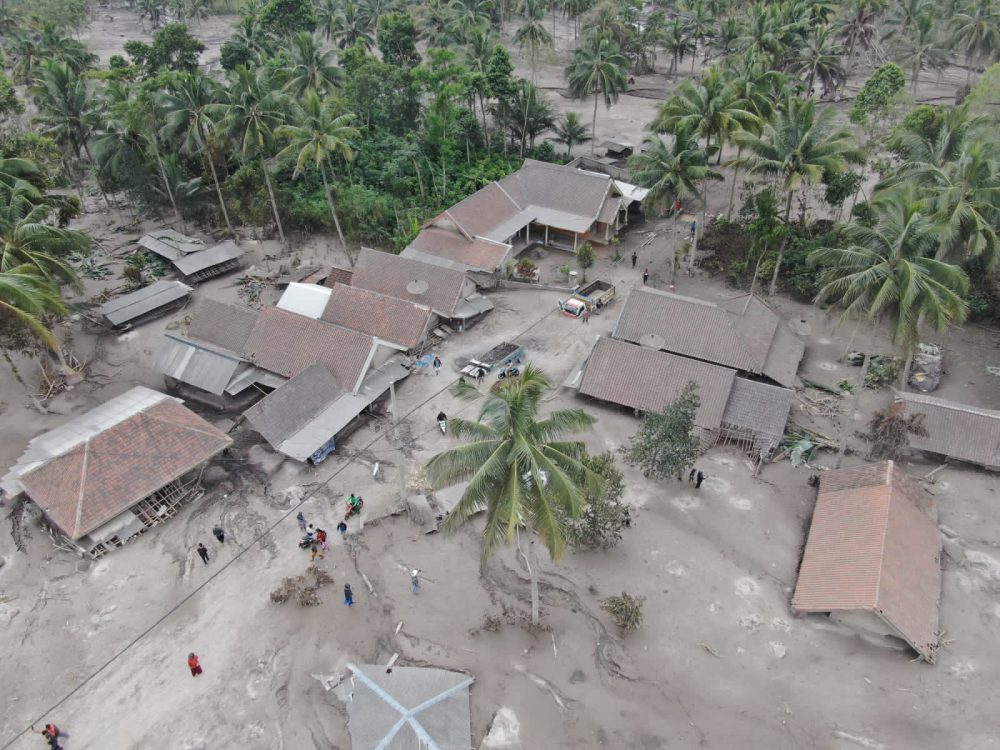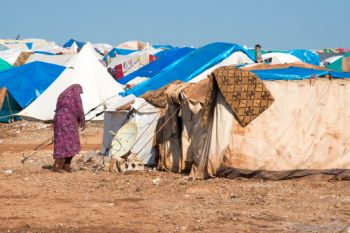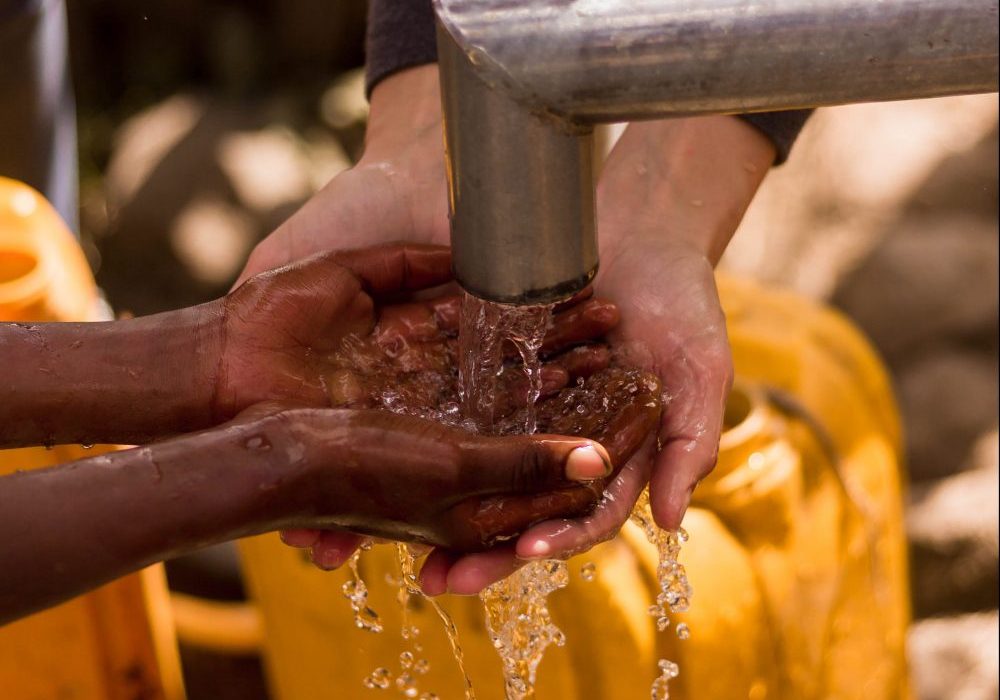

Indonesia’s Java Island experienced several days of heavy rain that left a heavy pool of water on the lava dome at the top of Mount Semeru in East Java.
Indonesia’s Java Island experienced several days of heavy rain that left a heavy pool of water on the lava dome at the top of Mount Semeru in East Java. On Dec. 4, 2021, the lava dome collapsed, unleashing the molten lava beneath in an explosive eruption that sent thousands of people fleeing the area. The eruption sent volcanic dust, lava and mud flows racing down the flanks of the mountain towards local communities. Although many people were able to escape, others were caught in the lava and mud that barreled down the slopes, as well as the ash that fell.
Later that month and into early January 2022, the eruption at Semeru continued with ash falling, crater incandescence and pyroclastic flows – hot gases and volcanic matter – all reported between Dec. 29, 2021 and Jan. 4, 2022.
Mount Semeru is currently (as of January 2022) on Level 3 caution status according to the Centre for Volcanology and Geological Hazard Mitigation (PVMBG).
(Photo credit: National Disaster Mitigation Agency via Twitter)
What is the impact on communities?
As of Dec. 18, 2021, the International Federation of Red Cross and Red Crescent Societies, reported that “2,970-unit houses, 31 public facilities, 42 schools, 1 health facilities, 12 praying houses and 1 bridge damaged by the hot ashes and avalanches. Communities also lost their livestock such as cow, goat and chickens and agricultural stock such as rice, corn and vegetables.”
Local disaster officials confirmed 46 people died, with nine still missing. Save the Children confirmed that at least seven of the deceased were children. At least 144 people suffered injuries – 32 were severely injured and 82 mildly injured – with burns of varying severity. More than 10,000 people have been affected, including more than 9,100 evacuees.
For those who survived, life won’t return to normal for months or even years to come. Once the volcano stops erupting, there will be the challenge of cleaning debris and ash from buildings, homes, roads, vegetation and other infrastructure in the area. The ash reached the rooftops in some locations.
Health care
Organizations on the ground in Indonesia have identified the need for Personal Protective Equipment and Trauma Supplies such as bandages and sutures. Survivors will also likely need treatment for respiratory issues due to the ash, especially those who have had COVID-19.
Logistics
The Deputy Regent of Lumajang, the area most affected, has asked for support with aerial monitoring, preparation of evacuation centers, public kitchens and vehicles for distribution of relief supplies.
Shelter and immediate relief supplies
For those displaced by the eruption and in the path of the lava, debris and ash. Currently, shelters consist of schools, community buildings, houses of worship or tent camps.
Safe spaces for children and other at-risk groups
Protection is always critical for women, older adults, people with disabilities and children as they are considered to be most in danger of violence or exploitation after a disaster. This is particularly important for those separated from family or caregivers.
Debris clean-up
The height of the ash means that debris clean-up will be a lengthy process that must be done before families can return to their homes. This is always more challenging in island communities such as Indonesia as there is limited land to dump debris, much of which may be toxic.
Rebuilding homes
Given the large number of damaged and destroyed homes, rebuilding support will be crucial. It is important that workers are hired and supplies purchased locally to help rebuild the economy.

The Center for Disaster Philanthropy (CDP) has a Global Recovery Fund that provides an opportunity for donors to meet the ongoing and ever-expanding challenges presented by global crises.
Contact CDP
Philanthropic contributions
If you would like to make a donation to the CDP Global Recovery Fund, please contact development.
Recovery updates
If you are a responding NGO or a donor, please send updates on how you are working on recovery from this disaster to tanya.gulliver-garcia@disasterphilanthropy.org.
We welcome the republication of our content. Please credit the Center for Disaster Philanthropy.
Donor recommendations
If you are a donor looking for recommendations on how to support recovery from this disaster, please email regine.webster@disasterphilanthropy.org.
Philanthropic and government support
CDP awarded a $121,500 grant to YAKKUM Emergency Unit to promote the psychosocial wellbeing of communities affected by the Mount Semeru volcano eruption in Indonesia and enable recovery by restoring livelihoods and strengthening community preparedness capacity for future disasters.
There are almost 60 organizations on the ground in Indonesia working on getting relief to those who need it the most. As with most disasters, cash donations are recommended by disaster experts as they allow for on-the-ground agencies to direct funds to the greatest area of need, support economic recovery and ensure donation management does not detract from disaster recovery needs. When considering donating to an organization in an international disaster, CDP recommends finding out how long the organization has been working in those specific communities, and the partnerships/relationships they have on the ground. We also endorse principles of localization including hiring local workers and paying them a fair wage, listening to the needs of the community, and supporting existing local organizations.
Cashlez, a financial technology company said that, “The #BahuMebahu collaboration between Cashlez and ACT which also invites Cashlez merchants has succeeded in raising funds of [$1,400 USD] 20 million 8 thousand rupiahs to help victims of the Mount Semeru eruption disaster in East Java Province. The donation fund has been distributed through Aksi Cepat Tanggap (ACT) by sharing 60 food packages for 60 heads of families (KK) or 300 survivors in the Sumberwuluh Village Refuge, Kec. Candipuro Kab. Lumajang.”
Siemens Indonesia employees held a fundraising campaign for the Indonesian Red Cross which was matched by the company. A donation of $7,000 (IDR 100,000,000) was made.
A donation of nearly $525, 000 (Rp7.5 billion) was donated from the Central Kalimantan administration to the East Java provincial government in early December. The Yogyakarta city disaster mitigation agency sent, “20 thousand medical masks, four thousand hand sanitizers, 576 bath soaps, and 100 pairs of boots.”
Related resources

Emergency and Interim Shelter
After a disaster, shelter is more than a place to rest, it is a place of security, access to food, water and medical treatment. A place to start recovering after a disaster.

Water, Sanitation and Hygiene (WASH)
Water is one of the most necessary elements for life, yet according to the World Health Organization/UNICEF, 2.1 billion people lack access to safely managed drinking water. In addition, 4.5 billion people lack safely-managed sanitation facilities. Water, sanitation and hygiene (WASH) principles are of tremendous concern in everyday life, but can be heightened during an emergency or disaster.

Is your community prepared for a disaster?
Explore the Disaster Playbook